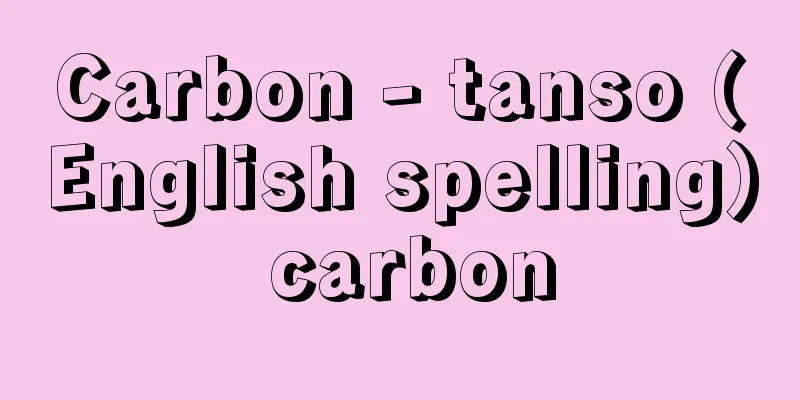Carbon - tanso (English spelling) carbon

|
It belongs to group 14 of the periodic table and is one of the carbon group elements. It is also called carbon. historyCharcoal has been a universal material used by all peoples around the world since ancient times, not only as fuel but also as an antiseptic and in smelting metals. Diamonds are also mentioned in the Old Testament and ancient Indian scriptures. The name diamond comes from the Greek word admas, meaning unconquerable, as there is nothing harder than it, and graphite (the mineral name is graphite) comes from the Greek word graphein, meaning to write, as it was used for writing in ancient times. The origin of the word carbon is unclear, but it is thought to come from the Latin word carbo, meaning charcoal. It became known that diamonds are made of carbon when France's Macaire burned diamond in 1771, and was proven by France's Lavoisier's experiment in 1772. That is, it was discovered that when a diamond placed in a sealed glass bell is irradiated with light focused by a lens and heated and burned, only carbon dioxide is produced. Furthermore, France's Guiton de Morbos showed that diamonds turn into carbon dioxide via graphite, and it was discovered that diamonds and graphite are allotropes of carbon. Many attempts have been made since the 19th century to produce diamonds from carbon, but without success. However, in 1955, researchers at General Electric in the United States succeeded in producing artificial diamonds using an iron-nickel alloy as a solvent under high temperature and ultra-high pressure. In Japan, diamonds have been mass-produced since 1961 (Showa 36). [Kenichi Morinaga and Katsunori Nakahara] ExistenceIt is the fourth most abundant element in the universe and is involved in the energy cycle of stars. Diamonds have also been found in meteorites. It exists in hydrological rocks, mainly as carbonates such as limestone, calcite (CaCO 3 ) , magnesite (MgCO 3 ) , and dolomite (CaCO 3·MgCO 3 ). It also accounts for about 0.03% of carbon dioxide in the atmosphere, and is in equilibrium with total carbon dioxide in seawater (H 2 CO 3 , HCO 3 - , and CO 3 2- ). It is an important component of the biosphere as a fuel source, as a component of coal and petroleum, which are important raw materials for industrial chemicals, and as an organic compound. Most of the energy needed to sustain life and power machines and other things comes from the oxidation of carbon and its compounds. Plants synthesize carbohydrates (also called hydrocarbohydrates or sugars) from carbon dioxide and water in the air through photosynthesis. Animals ingest these carbohydrates and release carbon dioxide back into the atmosphere through respiration, and after death, through the decomposition of their body tissues by bacteria. The link in the chain that connects animals and plants is the carbon cycle on the Earth's surface. [Kenichi Morinaga and Katsunori Nakahara] Carbon isotopesThe naturally occurring isotopic composition is 98.90% carbon-12, 1.10% carbon-13, and four other radioactive isotopes: carbon-10, carbon-11, carbon-14, and carbon-15. Carbon-12 was chosen as the standard for atomic weight, with one atomic mass unit being one-twelfth of the mass of one carbon-12 atom. Only carbon-13 has nuclear spin, and is therefore used to determine the structure of organic compounds by nuclear magnetic resonance spectroscopy. Carbon-14 (β - radiation, half-life 5730 years) is widely used as a tracer and is produced by the nuclear reaction 14 N(n,p) 14 C. In the upper atmosphere, carbon-14 is naturally replenished from neutrons and nitrogen produced by cosmic rays, so the amount of carbon-14 in carbon dioxide in the air is almost constant. When this carbon-14 is fixed as organic matter in living organisms, replenishment stops and it decreases with a half-life of about 5000 years. If we know the amount of carbon-14 when the organic matter was created, we can measure how much it has decreased now and know the time that has passed since the organism was alive. In this way, carbon-14 is used for dating. [Kenichi Morinaga and Katsunori Nakahara] Carbon allotropes and their structural differencesIt has been said that there are three allotropes of carbon: diamond, graphite, and amorphous carbon. Recently, however, fullerene (1985), carbon nanotubes (1991), and carbyne (1992) have been discovered. Carbyne is a black substance obtained by oxidizing acetylene in the presence of a catalyst, and is a hexagonal semiconductor. There are polyyne types with repeated -C≡C- and cumulene types with stacked =C=C=C= double bonds, but both are linear molecules with a chain structure. The electron configuration of the outermost shell of carbon is 2s 2 2p 2 , and there are three ways that a carbon atom can form a covalent bond with these four valence electrons. Two of these, sp 3 hybridization and sp 2 hybridization, are seen in the structures of diamond and graphite, respectively ( ). In sp 3 hybridization, the carbon atom forms four equivalent bonds using four orbitals that point from the center of a regular tetrahedron to the vertices. Diamond is a giant molecule in which the carbon atom at the center of a regular tetrahedron bonds with four other carbon atoms at each vertex of the tetrahedron in a three-dimensional configuration. On the other hand, in sp 2 hybridization, the carbon atom forms three equivalent bonds using three orbitals that point from the center of an equilateral triangle to the vertices, and the remaining p orbital points perpendicular to the plane of the triangle. In graphite, the carbon atom at the center of the triangle bonds with the carbon atoms at each vertex of the equilateral triangle to form a net-like plane that looks like a fused regular hexagonal six-membered carbon ring, and these are regularly stacked to form a layered structure. In the same plane, each carbon atom is covalently bonded to three other carbon atoms with three electrons, and the remaining electron is mobile like an electron in a metal (the electron of a carbon atom in a p orbital perpendicular to the plane makes and breaks bonds with the same type of p electrons of all the surrounding atoms. In other words, the p electrons move around the carbon atoms in a network plane made of six-membered carbon rings). The carbon planes are bound together by weak van der Waals forces. Diamond, a giant molecule in which all four valence electrons of a carbon atom are used in covalent bonds, is hard and does not conduct electricity, while graphite conducts electricity and is soft and easy to cleave. This difference in structure between the two is the reason why intercalation compounds such as CF and C 2 K are known as graphite derivatives. So-called amorphous carbon includes charcoal, animal charcoal, soot, carbon black, and coke. Amorphous carbon is a material in which the mesh of fine graphite crystals is disordered and the layers are distorted, and the size of the carbon planes and the way they are stacked vary depending on how it is made. Graphite is somewhat more chemically reactive than diamond, but amorphous carbon is even more reactive than graphite. At high temperatures, it directly combines with many elements. For example, it combines with hydrogen and sulfur to form hydrocarbons such as acetylene and carbon disulfide, respectively, and with silicon, calcium, aluminum, and iron to form carbides. It also acts as a reducing agent, removing oxygen from many oxides to produce carbon monoxide and carbon dioxide. It is extremely stable against chemicals such as alkalis. See for the properties of carbon. Fullerenes, carbon nanotubes, carbynes, and the like are known as the new carbon family, and are expected to be applied in a variety of fields. [Kenichi Morinaga and Katsunori Nakahara] Manufacturing methodCarbon materials with many industrial uses are obtained in the following way. After pyrolysis of the raw organic matter, elements other than carbon are released at high temperatures (carbonization), and this is then heat-treated at around 3000°C to make it closer to a graphite structure (graphitization). Carbon black is made by pyrolyzing hydrocarbon gas or oil into a mist at 1300°C or higher. Artificial graphite is made by forming coke with a binder, baking it, and then heating it to 3000°C to graphitize it. High-purity graphite can be obtained by treating it at high temperatures while passing halogen gas through it. Other carbon materials with special high functionality have been developed, such as carbon fiber (light and strong) made by heat-treating fibers such as polyacrylonitrile and then carbonizing them in the solid phase, glassy carbon (isotropic conductor), and pyrolytic carbon. [Kenichi Morinaga and Katsunori Nakahara] ApplicationsIn addition to being used as a gemstone, diamonds are also used as an abrasive and cutting material, taking advantage of their hardness. Graphite is used as a neutron moderator in nuclear reactors, various electrodes, crucibles, pencil leads, anti-friction materials, etc. Amorphous carbon has a variety of uses, including as a fuel, depending on its shape and properties. Powdered activated carbon is important as an adsorbent, and fine particles of carbon black are used in pigments, printing inks, and rubber fillers. Carbon fiber is used in various sporting goods as a high-strength, high-tensile carbon fiber. [Kenichi Morinaga and Katsunori Nakahara] "The Chemistry of Fullerene, the Third Carbon Allotrope," edited by the Chemical Society of Japan (1999, Academic Press Center)" ▽ "Carbon Application Technology, Popular Edition, by Shimazaki Katsunori et al. (2001, CMC)" ▽ "The Carbon Society of Japan, Edited by The Latest Carbon Material Experimental Technology: Analysis and Characterization Edition" and "The Latest Carbon Material Experimental Technology: Physical Properties and Material Evaluation Edition" (2001, 2003, Cypeck)" [References] | | | | | | | | | | | [Supplementary information] |©Shogakukan "> Periodic Table ©Shogakukan "> Carbon structure (diagram) ©Shogakukan "> Properties of Carbon (Table) Source: Shogakukan Encyclopedia Nipponica About Encyclopedia Nipponica Information | Legend |
|
周期表第14族に属し、炭素族元素の一つ。カーボンともいう。 歴史木炭は古代から世界各民族普遍のものであり、燃料とするだけでなく、防腐剤、あるいは金属製錬に用いられていた。またダイヤモンドについては『旧約聖書』や、インドの古代聖典にも記載がある。ダイヤモンドの名は、これ以上の硬さのものがないことから、征服されないという意味のギリシア語admasに由来し、黒鉛(鉱物名は石墨(せきぼく)、グラファイト)は古く筆記に使われたことから、書くという意味のギリシア語grafeinに由来する。炭素carbonの語源ははっきりしないが、ラテン語の木炭carboに由来するらしい。 ダイヤモンドが炭素からなることが知られるようになったのは、1771年フランスのマケールのダイヤモンドの燃焼に始まり、1772年フランスのラボアジエの実験によって証明された。すなわち密閉ガラス鐘中のダイヤモンドにレンズで集光して照射、加熱燃焼させると二酸化炭素のみを生ずることを発見したことによる。さらにフランスのギトン・ドゥ・モルボが、ダイヤモンドが石墨を経て二酸化炭素となることを示し、ダイヤモンドと石墨が炭素の同素体であることがわかった。 炭素からのダイヤモンドの製造は、19世紀から多くの試みがなされたが成功しなかった。しかし1955年アメリカのゼネラルエレクトリック社の研究者たちは、高温、超高圧下で、鉄‐ニッケル合金を溶媒にして人工ダイヤモンドの製造に成功した。日本でも1961年(昭和36)以降量産されている。 [守永健一・中原勝儼] 存在宇宙には4番目に多い元素で、恒星のエネルギーサイクルに含まれる。ダイヤモンドは隕石(いんせき)中にもみつかっている。主として石灰石や方解石CaCO3、マグネサイトMgCO3、ドロマイトCaCO3・MgCO3のような炭酸塩として水成岩中に存在する。また、二酸化炭素として大気中に約0.03%含まれ、海水中の全炭酸(分子状のCO2のほかH2CO3、HCO3-、CO32-)はこれと平衡を保っている。燃料源として、また工業的に重要な化学薬品の原料となる石炭や石油の成分として、さらに有機化合物として生物圏の重要な構成成分である。生命の維持と機械その他の動力源として必要なエネルギーの大部分は、炭素とその化合物の酸化反応に仰いでいる。植物は空気中の二酸化炭素と水から光合成により炭水化物(含水炭素または糖類ともいう)を合成する。動物はこの炭水化物を摂取して呼吸作用により、また死後はバクテリアによる肉体組織の分解により二酸化炭素を大気に戻す。このような動物と植物を結び付ける鎖の輪が地表における炭素のサイクルである。 [守永健一・中原勝儼] 炭素の同位体天然に存在する同位体組成は、炭素12が98.90%、炭素13が1.10%、ほかに放射性同位体の炭素10、炭素11、炭素14、炭素15の4種類がある。炭素12は原子量の基準として選ばれ、炭素12原子1個の質量の12分の1が1原子質量単位である。炭素13のみが核スピンをもつので、核磁気共鳴吸収法による有機化合物の構造決定に利用される。 炭素14(β(ベータ)-放射、半減期5730年)はトレーサーとして広く使われ、核反応14N(n,p)14Cによってつくられる。天然による上層大気中では宇宙線によってつくられる中性子と窒素から炭素14が補給されるので、空気中の二酸化炭素に含まれる炭素14の量はほぼ一定である。これが生物体の有機物として固定されると、補給が止まり約5000年の半減期で減少する。もし有機物がつくられたときの炭素14の量がわかれば、現在それがどれだけ減少しているかを測って、その生物が生きていたときから現在までの経過時間を知ることができる。このように炭素14は年代測定に利用される。 [守永健一・中原勝儼] 炭素の同素体、その構造の相違炭素の同素体としてはダイヤモンド、黒鉛および無定形炭素の三つがあるとされてきたが、最近、フラーレン(1985)、カーボンナノチューブ(1991)、カルビン(1992)などが発見されている。カルビンはアセチレンを触媒の存在下酸化して得られる黒色物質で、六方晶系の半導体。-C≡C-が繰り返されるポリイン型と=C=C=C=二重結合の積み重なったクムレン型とがあるが、いずれも鎖状構造の直鎖分子である。 炭素の最外殻の電子配置は2s22p2で、炭素原子がこの合計4個の原子価電子によって共有結合をつくる方法には3通りがある。そのうちの2通りsp3混成とsp2混成とよばれる結合の仕方が、それぞれダイヤモンドと黒鉛の構造にみられる()。sp3混成では、正四面体の中心から頂点の方向に向かう4個の軌道を使って炭素原子は4個の等価な結合をつくる。ダイヤモンドは、正四面体の中心に位置する炭素原子が正四面体の各頂点に位置する4個の他の炭素原子と結合するという立体配置が三次元方向に伸びた巨大分子である。一方、sp2混成では、正三角形の中心から頂点の方向に向かう3個の軌道を使って炭素原子は3個の等価な結合をつくり、残る1個のp軌道は三角形の平面に垂直な方向を向いている。黒鉛では、炭素原子が三角形の中心にあって、正三角形の各頂点にある炭素原子と結合して正六角形の炭素6員環が融合したような網状平面ができあがり、それが規則的に積み重なった層状構造をとっている。同じ平面内で各炭素原子は3個の電子で他の3個の炭素原子と互いに共有結合し、残りの1個の電子は金属内の電子と同じように動きやすい状態になっている(平面に垂直なp軌道に入っている、ある炭素原子の電子が、周りのすべての原子の同じ種類のp電子と結合をつくったり、切ったりしている。すなわちp電子は炭素6員環からなる網状平面内の炭素原子上を動き回る)。炭素平面間を結び付けているのは弱いファン・デル・ワールス力である。炭素原子の4個の価電子がすべて共有結合に使われている巨大分子のダイヤモンドが硬くて電気を導かないのに、黒鉛が電気を導き、軟らかく劈開(へきかい)しやすい性質を示すのは、両者のこのような構造の差異に原因がある。黒鉛の誘導体としてCFとかC2Kなどの層間化合物が知られているのもこのためである。 いわゆる無定形炭素とよばれるものには木炭、獣炭、煤、カーボンブラック、コークスなどが含まれる。無定形というのは、黒鉛の微細結晶の網目が無秩序に乱れ、層もひずんだりして集合したもので、つくり方によって炭素平面の大きさやその積み重なり方も変わってくる。黒鉛はダイヤモンドよりいくぶん化学反応性が大きいが、無定形炭素は黒鉛よりもいっそう反応性が増している。高温では多くの元素と直接に化合する。たとえば、水素、硫黄(いおう)と化合してそれぞれアセチレンなどの炭化水素、二硫化炭素をつくり、ケイ素、カルシウム、アルミニウム、鉄などと炭化物をつくる。また、還元剤として多くの酸化物から酸素を奪って、一酸化炭素や二酸化炭素を生じる。アルカリなどの化学薬品に対してきわめて安定である。炭素の性質についてはも参照。 フラーレンやカーボンナノチューブ、カルビンなどは、いわゆるニューカーボンファミリーとよばれ、各種の分野での応用が期待されている。 [守永健一・中原勝儼] 製法工業的に多くの用途をもつ炭素材料は次のようにして得られる。原料有機物を熱分解したのち、高温で炭素以外の元素を放出させ(炭素化)、さらにこれを3000℃付近での熱処理によって黒鉛の構造に近づける(黒鉛化)方法がとられる。カーボンブラックは、炭化水素ガス、または油などを霧状にして1300℃以上で熱分解してつくる。人造黒鉛は、コークスを結合材と成形、焼成したのち、3000℃に熱して黒鉛化させる。ハロゲンガスを通しながら高温で処理すると高純度のものが得られる。このほか、ポリアクリロニトリルなどの繊維を加熱処理してそのまま固相炭素化させた炭素繊維(軽くて強い)やガラス状炭素(等方性の導電体)、熱分解炭素など特殊な機能性の高い炭素材料が開発されている。 [守永健一・中原勝儼] 用途ダイヤモンドは宝石として用いられるほか、その硬さを利用して研磨材や切削材料として用いられる。黒鉛は原子炉の中性子減速剤、各種の電極、るつぼ、鉛筆の芯、減摩材などに用いられる。無定形炭素はその形状や性質によって燃料その他いろいろな用途がある。粉末の活性炭は吸着材として重要であり、微粒子のカーボンブラックは顔料、印刷インキ、ゴムの充填(じゅうてん)剤などに用いられる。炭素繊維は高強度、高張性炭素繊維として各種スポーツ用品に用いられる。 [守永健一・中原勝儼] 『日本化学会編『炭素第三の同素体フラーレンの化学』(1999・学会出版センター)』▽『嶋崎勝乗他著『炭素応用技術』普及版(2001・シーエムシー)』▽『炭素材料学会編『最新の炭素材料実験技術 分析・解析編』『最新の炭素材料実験技術 物性・材料評価編』(2001、2003・サイペック)』 [参照項目] | | | | | | | | | | | [補完資料] |©Shogakukan"> 周期表 ©Shogakukan"> 炭素の構造〔図〕 ©Shogakukan"> 炭素の性質〔表〕 出典 小学館 日本大百科全書(ニッポニカ)日本大百科全書(ニッポニカ)について 情報 | 凡例 |
Recommend
Koshi-ko - Kinoeneko
…He was also worshipped as the god of the fields,...
Oroshino score - Oroshinofu
...This is the section that is placed after the &...
Kawachi Province
The old name of the province in the southeastern ...
Ife Culture
…The sculptures of the Nok culture show a fairly ...
Revenge - Vengeance
〘Noun〙① When a lord, parent, husband, etc. is kill...
Trebenište (English spelling)
…A small clay statue with exaggerated eyes and no...
Modern Port - Kindai Kowan
…Construction of Nobiru Port began in 1978 based ...
ad hoc
...Also, when a certain hypothesis encounters an ...
Tarch(u)na (English spelling) Tarchna
…An ancient Etruscan city located about 80 km nor...
Hou Jing Rebellion
In August 548 (the second year of the Taiqing era)...
Kipping, FS - Kipping
...Industrially important fluorine compounds such...
Yunotani [Village] - Yunotani
A village in Kita-Uonuma County, southeastern Niig...
Chinggis Khan
1167‐1227 Founder of the Mongol Empire. Reigned 12...
Viscount Castlereagh, 2nd Marquis of Londonderry
British politician. Castlereagh was his nickname....
Rhomborrhina polita (English spelling) Rhomborrhinapolita
… [Chokane Hayashi]. … *Some of the terminology t...









